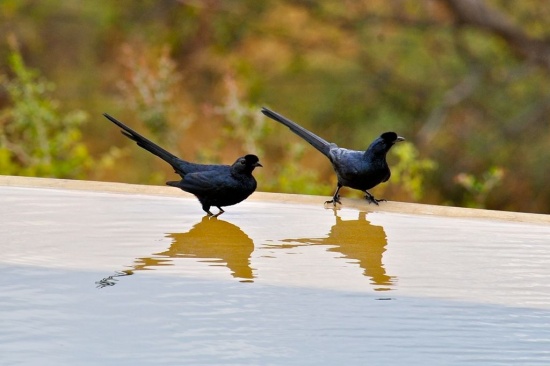- Onychognathus salvadorii
Identification
Approximately 16" / 40cm. A very large Starling with a very long, graduated tail.
- Black forehead with a small cushion of bristly feathers
- Dark blue face, upper and underparts
- Dark collar and throat
- Black wing with reddish-brown primaries
- Long dark blue tail
- Deep crimson iris
Females have a shorter tail and have some greyish feathers around the eye and on ear-coverts. Juveniles are duller with only a faint gloss.
Distribution
Eastern Africa: found in central Ethiopia, northwestern and southern Somalia, and northern Kenya.
Locally common but patchily distributed.
Taxonomy
This is a monotypic species[1].
Habitat
Mountainous dry bush country, cliffs and gorges, near water. Generally below 1300m.
Behaviour
Feeds mainly on fruit, takes also seeds.
Forages in pairs or small flocks in bushes.
Breeding season April in Ethiopia, May to June and September in Kenya. A monogamous species, possibly froming loose colonies. The nest is placed in a hole in a cliff.
Presumably a resident species.
References
- Clements, J. F., T. S. Schulenberg, M. J. Iliff, D. Roberson, T. A. Fredericks, B. L. Sullivan, and C. L. Wood. 2017. The eBird/Clements checklist of birds of the world: v2017, with updates to August 2017. Downloaded from http://www.birds.cornell.edu/clementschecklist/download/
- Kenya Birds
- Del Hoyo, J, A Elliott, and D Christie, eds. 2009. Handbook of the Birds of the World. Volume 14: Bush-shrikes to Old World Sparrows. Barcelona: Lynx Edicions. ISBN 978-8496553507
Recommended Citation
- BirdForum Opus contributors. (2025) Bristle-crowned Starling. In: BirdForum, the forum for wild birds and birding. Retrieved 13 May 2025 from https://www.birdforum.net/opus/Bristle-crowned_Starling





